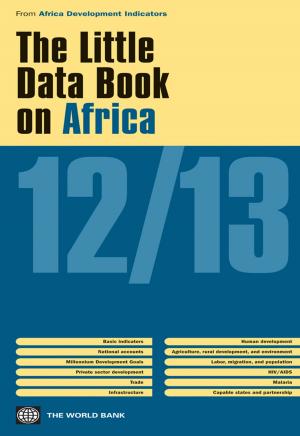Africa's Infrastructure: A Time For Transformation
Business & Finance, Business Reference, Infrastructure| Author: | Foster Vivien; Briceño-Garmendia Cecilia M. | ISBN: | 9780821380413 |
| Publisher: | World Bank | Publication: | December 1, 2009 |
| Imprint: | Language: | English |
| Author: | Foster Vivien; Briceño-Garmendia Cecilia M. |
| ISBN: | 9780821380413 |
| Publisher: | World Bank |
| Publication: | December 1, 2009 |
| Imprint: | |
| Language: | English |
Sustainable infrastructure development is vital for Africa's prosperity. And now is the time to begin the transformation. This volume is the culmination of an unprecedented effort to document, analyze, and interpret the full extent of the challenge in developing Sub-Saharan Africa's infrastructure sectors. As a result, it represents the most comprehensive reference currently available on infrastructure in the region. The book covers the five main economic infrastructure sectors information and communication technology, irrigation, power, transport, and water and sanitation. Africa's infrastructure sectors lag well behind those of the rest of the world, and the gap is widening. Some of the main policy-relevant findings highlighted in the book include the following: infrastructure in the region is exceptionally expensive, with tariffs being many times higher than those found elsewhere. Inadequate and expensive infrastructure is retarding growth by 2 percentage points each year. Solving the problem will cost over US90 billion per year, which is more than twice what is being spent in Africa today.However, money alone is not the answer. Prudent policies, wise management, and sound maintenance can improve efficiency. There is the potential to recover an additional US17 billion a year from within the existing infrastructure resource envelope simply by improving efficiency.Finally, the power sector and fragile states represent particular challenges. Even if every efficiency in every infrastructure sector could be captured, a substantial funding gap of 31 billion a year would remain. Nevertheless, the African people and economies cannot wait any longer. Now is the time to begin the transformation to sustainable infrastructure development.
Sustainable infrastructure development is vital for Africa's prosperity. And now is the time to begin the transformation. This volume is the culmination of an unprecedented effort to document, analyze, and interpret the full extent of the challenge in developing Sub-Saharan Africa's infrastructure sectors. As a result, it represents the most comprehensive reference currently available on infrastructure in the region. The book covers the five main economic infrastructure sectors information and communication technology, irrigation, power, transport, and water and sanitation. Africa's infrastructure sectors lag well behind those of the rest of the world, and the gap is widening. Some of the main policy-relevant findings highlighted in the book include the following: infrastructure in the region is exceptionally expensive, with tariffs being many times higher than those found elsewhere. Inadequate and expensive infrastructure is retarding growth by 2 percentage points each year. Solving the problem will cost over US90 billion per year, which is more than twice what is being spent in Africa today.However, money alone is not the answer. Prudent policies, wise management, and sound maintenance can improve efficiency. There is the potential to recover an additional US17 billion a year from within the existing infrastructure resource envelope simply by improving efficiency.Finally, the power sector and fragile states represent particular challenges. Even if every efficiency in every infrastructure sector could be captured, a substantial funding gap of 31 billion a year would remain. Nevertheless, the African people and economies cannot wait any longer. Now is the time to begin the transformation to sustainable infrastructure development.















